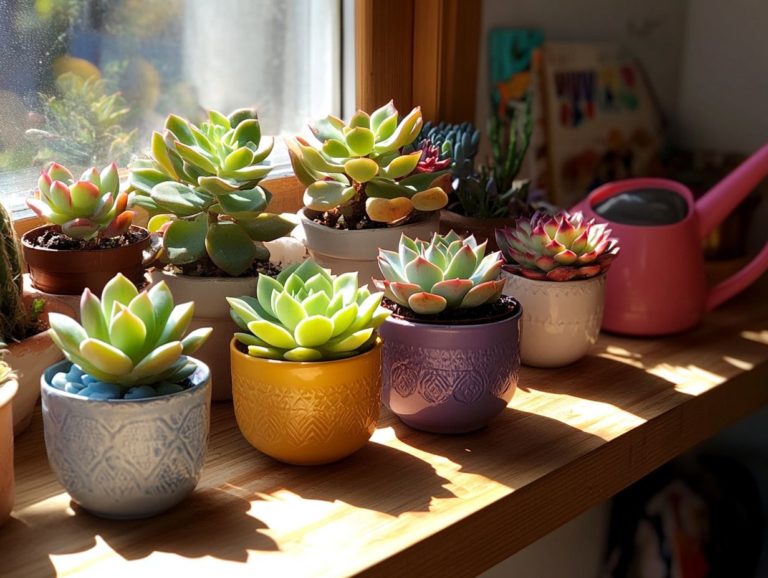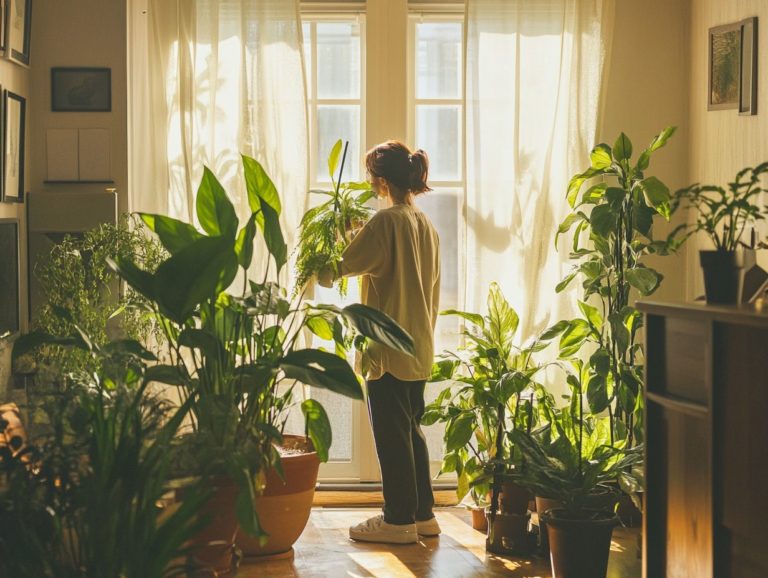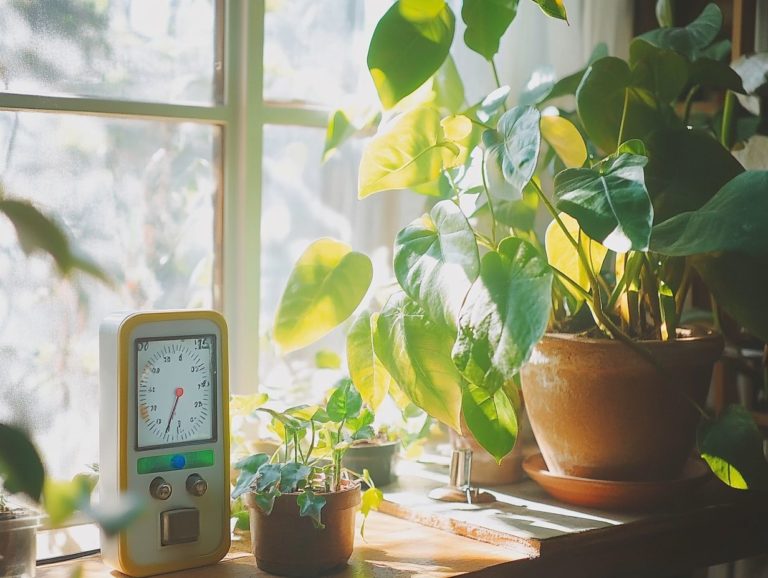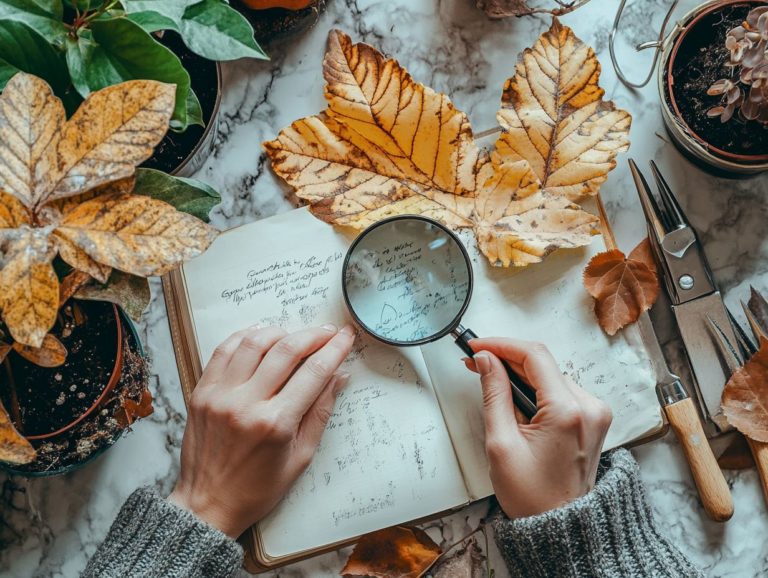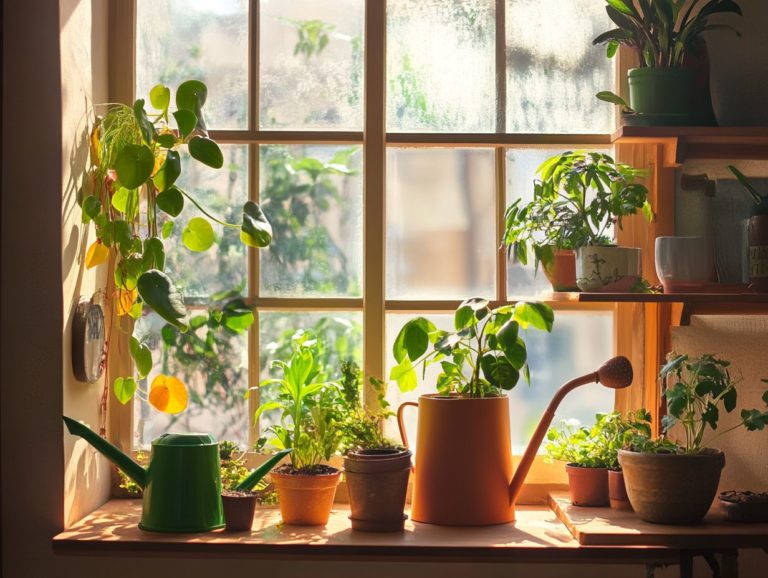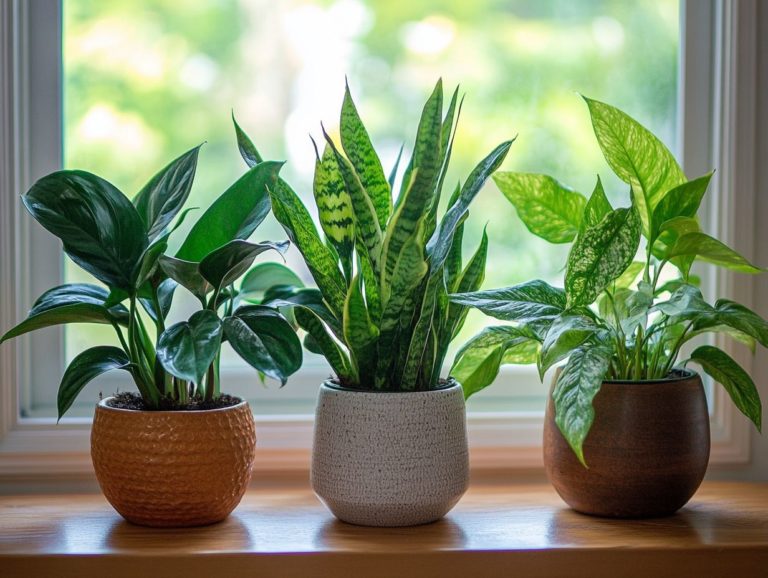How to Identify Common Indoor Plant Diseases?
Indoor plants have the remarkable ability to infuse life and beauty into your home. However, they can also be susceptible to a range of diseases that threaten their vitality.
Recognizing the signs and symptoms of indoor plant diseases is essential for any serious plant enthusiast. Get ready to learn about the common signs that show your plants need help, assist you in identifying potential causes, and provide effective strategies for both prevention and treatment.
You ll explore various types of diseases that can target your plants, including fungal, bacterial, and viral infections. By the time you finish, you ll be fully equipped to ensure your indoor garden flourishes beautifully.
Contents
- Key Takeaways:
- Spotting Plant Problems Early!
- Identifying the Cause of Plant Diseases
- Preventing and Treating Indoor Plant Diseases
- Common Types of Indoor Plant Diseases
- Frequently Asked Questions
- What are some signs of common indoor plant diseases?
- How can I tell if my indoor plant has a fungal disease?
- Are there any common diseases that affect multiple types of indoor plants?
- What is the best way to diagnose a disease on my indoor plants?
- Can I prevent common indoor plant diseases?
- What should I do if I suspect my indoor plant has a disease?
Key Takeaways:

- Be observant of visual cues and changes in your plant’s health to identify potential diseases early.
- Understand the possible causes and contributing factors of plant diseases to effectively prevent and treat them.
- Familiarize yourself with common types of indoor plant diseases, such as fungal, bacterial, and viral, to better manage and protect your plants.
What are Indoor Plant Diseases?
Indoor plant diseases pose a significant challenge for you as a houseplant enthusiast. They impact the health and growth of your beloved greens due to various factors like environmental conditions and care practices. Fungal infections such as gray mold, root rot, and powdery mildew can wreak havoc on your indoor plants if you don t identify and treat them promptly.
Understanding these plant diseases is crucial for maintaining a flourishing indoor garden. It helps you recognize symptoms and implement preventive measures to shield against potential outbreaks. Additionally, knowing how to identify and treat soil of indoor plants can further enhance plant health.
Pathogens thrive when conditions are right, often exacerbated by excessive humidity or poor airflow. These conditions are common in inadequately ventilated spaces, leading to fungal infections like gray mold and powdery mildew. For instance, gray mold loves to hang out in areas where moisture gathers. Root rot becomes a problem when plants languish in overly saturated soil, robbing roots of vital oxygen. Fluctuating light levels can also weaken plants, making them more vulnerable to illness.
To cultivate healthier plants, prioritize optimizing your growing conditions. Ensure proper drainage, regularly monitor humidity levels, and select quality soil that promotes robust growth and resilience against diseases.
Spotting Plant Problems Early!
Recognizing common signs and symptoms of plant diseases is crucial for you as an indoor gardener striving to cultivate healthy plants and achieve optimal growth. Symptoms can appear in various forms, such as yellowing leaves, leaf drop, and unsightly leaf spots. These can indicate underlying issues such as non-living factors affecting plants or cultural problems in plant care.
These symptoms often signal underlying problems, whether they stem from fungal infections like gray mold and powdery mildew or environmental stressors such as light requirements and temperature. Paying attention to these signs enables you to address potential issues before they escalate. If you’re unsure how to proceed, consider consulting resources on indoor plant problems to ensure your indoor garden thrives.
Visual Cues and Changes in Plant Health
Visual cues are essential for assessing the health of your indoor plants. Any changes can signal the presence of diseases or pest infestations. By observing details like leaf coloration, texture, and overall vigor, you can swiftly identify any issues affecting your plants’ growth, allowing for timely intervention to restore their health.
For instance, yellowing leaves might indicate nutrient deficiencies, while wilting could point to underwatering or root rot. Also, spots or patches on the foliage often suggest pest activity or fungal infections, both of which can compromise the plant’s structural integrity over time. Monitoring these signs closely and identifying common plant species problems can significantly impact outcomes.
Regular maintenance is also key. Cleaning the leaves to remove dust and potential pests, along with maintaining optimal humidity and temperature levels, greatly enhances your chances of preventing health problems before they escalate into more serious issues.
Start checking your plants today to ensure they re thriving!
Identifying the Cause of Plant Diseases

Identifying the root causes of plant diseases helps you develop effective management and prevention strategies. Factors like overwatering, underwatering, and pest challenges can hurt your indoor plants. Understanding these causes enables you to apply targeted solutions.
This proactive approach enhances your plant care and fosters resilience against common diseases.
Possible Causes and Contributing Factors
Various causes can trigger indoor plant diseases, with environmental conditions playing a crucial role. Soil moisture levels, light requirements, and proper drainage are essential for preventing issues like root rot and fungal infections. Improper watering habits can worsen these problems.
Understanding the relationship between humidity and temperature is crucial. Excessive heat stresses your plants, making them vulnerable to pests and diseases. To maintain optimal conditions, keep your indoor plants away from direct heat sources and drafts. Regularly checking soil moisture is crucial; consider using a moisture meter to avoid over or under-watering, as this significantly impacts root development.
Good airflow can stop mildew from forming. By following these practices, you can create a healthier environment, minimizing indoor plant diseases and learning how to identify indoor plant toxicity symptoms.
Preventing and Treating Indoor Plant Diseases
Preventing and treating indoor plant diseases requires a proactive approach that combines vigilant monitoring with effective management strategies. By embracing preventive measures like ensuring proper air circulation, maintaining optimal humidity levels, and using high-quality soil you can significantly reduce the risk of common plant diseases.
Taking these steps will keep your plants safe and happy, creating a thriving environment for your cherished houseplants.
Effective Strategies for Disease Management
Implementing effective strategies for disease management is essential for maintaining healthy indoor plants. This includes cutting off damaged leaves and preventing the recurrence of plant diseases. By regularly monitoring your plants’ health and combining proactive pest control with routine cleaning to remove debris, you can enhance the resilience of your houseplants.
For optimal results, consider using natural pest control methods. This approach focuses on beneficial insects and eco-friendly treatments, reducing reliance on chemicals while promoting a balanced ecosystem.
Routine inspections for early signs of distress, like yellowing leaves or unusual spots, are vital. Establishing a cleaning routine such as gently wiping leaves to prevent dust and fungal growth also supports plant health.
By adopting these strategies, you can create a thriving indoor garden that remains free from disease, and if you encounter any problems, refer to our quick guide to common indoor plant issues.
Common Types of Indoor Plant Diseases
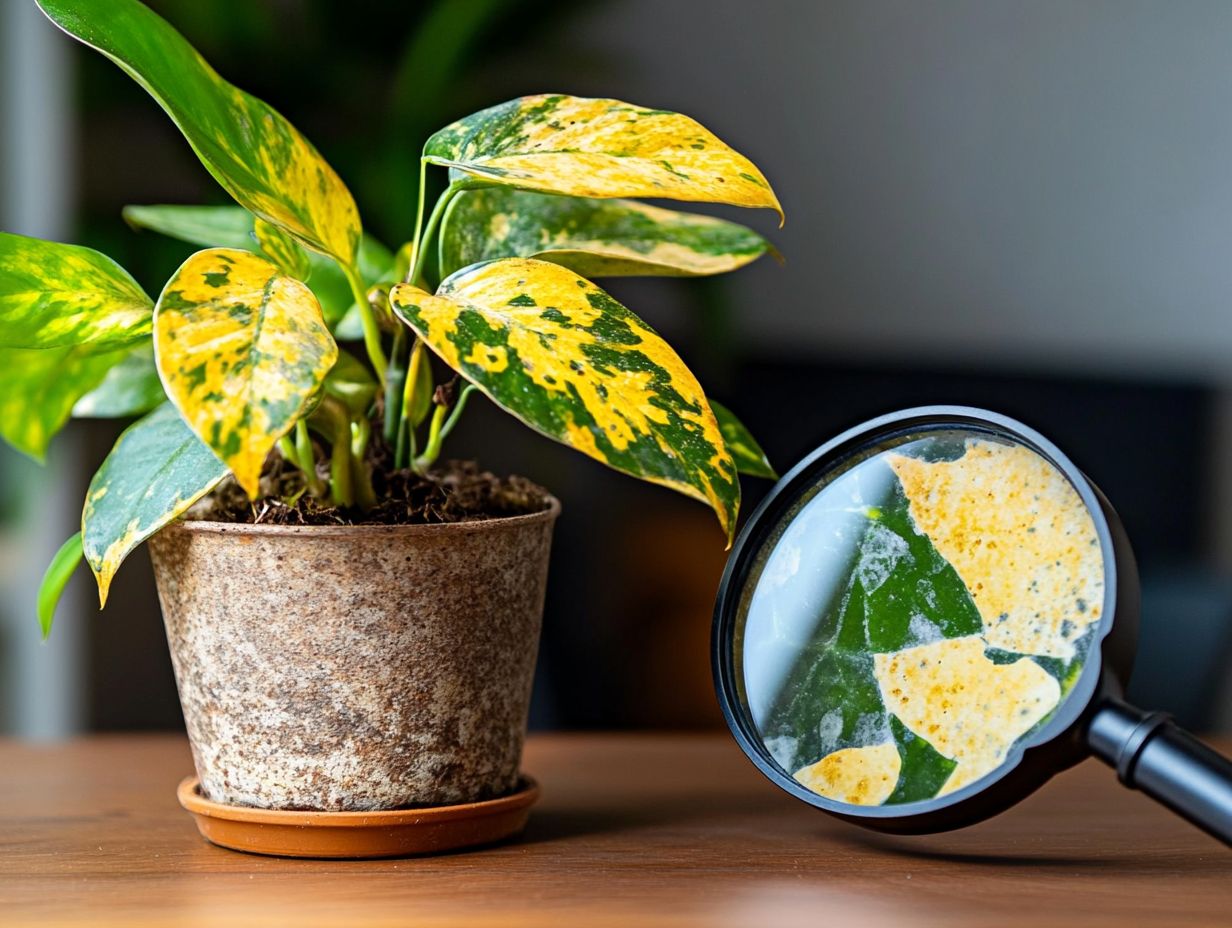
Understanding common types of indoor plant diseases is vital for any houseplant enthusiast. Each disease, such as fungal or bacterial infections, uniquely impacts your plants’ health. Recognizing these differences is key to their care.
These diseases generally fall into three main categories: fungal, bacterial, and viral. Each category presents distinct challenges and symptoms, necessitating tailored approaches for effective management and treatment.
Being well-informed allows you to navigate these issues with confidence, ensuring your indoor garden thrives.
Fungal Diseases
Fungal diseases pose a significant threat to indoor plants, with gray mold, powdery mildew, and root rot standing out as particularly notorious offenders that can dramatically compromise plant health. Grasping their symptoms and available treatment options is essential for effective management and the ongoing vitality of your houseplants.
These conditions often reveal themselves through a variety of symptoms, including wilting leaves, unsightly white fungal growth on surfaces, or even a rather unpleasant odor wafting from the soil. The root causes of these issues often lie in excess moisture, poor air circulation, or over-fertilization. To help identify potential problems, including pest damage, you can refer to our guide on identifying pest damage on indoor foliage. These factors create a welcoming environment for fungal invaders, such as Rhizoctonia and Pythium.
Treatment typically involves a combination of fungicides, adjusting your watering routine, and ensuring there’s ample airflow surrounding your plants. You’ll love how easy it is to keep your plants healthy with a few proactive steps like using well-draining soil, keeping the area around your plants tidy, and routinely checking for early warning signs of infection. For more detailed advice, refer to our guide on indoor plant care troubleshooting.
Bacterial Diseases
Bacterial diseases can present serious risks to your indoor plants, often revealing themselves through symptoms like unsightly leaf spots and wilting clear signs of underlying infections. Recognizing these symptoms early is crucial for taking effective control and treatment measures, particularly when considering various plant diseases.
In humid environments, these infections can spread like wildfire, so it’s essential to remain vigilant. Common bacterial diseases, such as bacterial leaf spot and blight, can lead to stunted growth and a general decline in your plants’ health. If you notice yellow leaves in your indoor plants, they often hitch a ride on contaminated tools or water, which underscores the importance of maintaining cleanliness during your plant care routine.
To treat bacterial diseases, remove infected foliage and apply suitable antibacterial solutions. Embrace good cultural practices like ensuring proper air circulation and avoiding overcrowding to significantly decrease the chances of these diseases taking root. Additionally, learning how to identify common indoor plant pests can help preserve the vitality of your cherished indoor greenery while addressing environmental conditions.
Viral Diseases
Viral diseases may be less frequent than their fungal and bacterial counterparts, but they can have a profound impact on plant health, manifesting symptoms like mottled leaves and stunted growth. Understanding common plant diseases and how these viruses spread is essential for nurturing a thriving indoor garden.
These pathogens can enter your plants through various channels, including tools and insects spreading disease. Infected plants might not just show leaf discoloration; they can also suffer from issues like blossom drop and diminished yields. It’s crucial to be aware of the top 5 indoor plant diseases to watch for, as these problems can ultimately affect your garden’s overall performance and highlight the importance of proper drainage and soil quality.
Effective management strategies involve removing infected specimens, selecting resistant plant varieties, and practicing good sanitation to curb the spread of these viruses. Keeping a vigilant eye on your plants for early signs of infection is crucial, enabling you to act swiftly.
Highlighting the significance of preventive measures like quarantining new additions and maintaining a tidy workspace can go a long way in protecting your indoor garden from the adverse effects of viral infections. Implementing pest management strategies is equally important.
Frequently Asked Questions
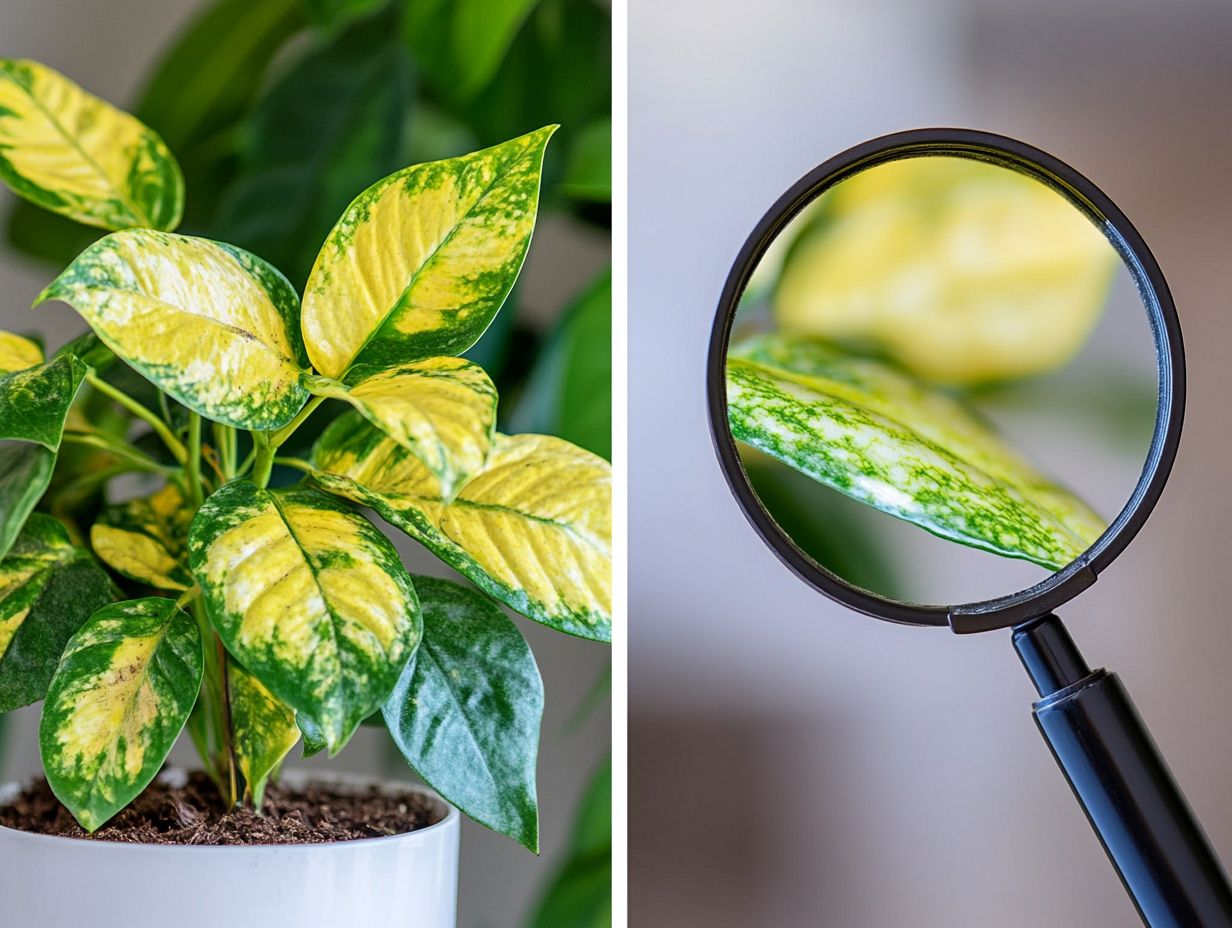
What are some signs of common indoor plant diseases?
Look for signs like yellowing leaves, wilting, and spots or lesions on leaves to identify common plant diseases. These symptoms can result from overwatering or environmental conditions.
To keep your indoor plants healthy, explore more resources on plant care and implement the tips discussed!
How can I tell if my indoor plant has a fungal disease?
Fungal diseases on indoor plants can be spotted by fuzzy growth on leaves or stems and unusual spots or discoloration. Wilting or distorted growth can also be a sign.
Are there any common diseases that affect multiple types of indoor plants?
Yes, some diseases like powdery mildew affect many indoor plants, including roses and tomatoes. This highlights why proper potting and soil moisture are crucial.
What is the best way to diagnose a disease on my indoor plants?
The best way to diagnose a disease on your indoor plants is to closely examine them for visible symptoms. Research common plant diseases and consult a plant expert if needed.
Can I prevent common indoor plant diseases?
While you may not prevent every disease, you can reduce the risk with proper watering and drainage. Avoid overcrowding and regularly inspect your plants for signs of disease.
What should I do if I suspect my indoor plant has a disease?
If you suspect your indoor plant has a disease, act fast! Isolate the affected plant, research the symptoms, and consider consulting a professional for diagnosis and treatment.

